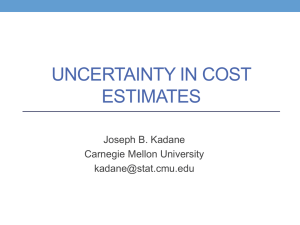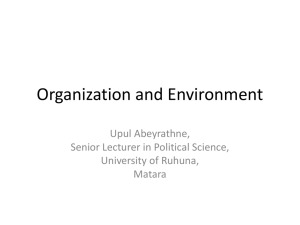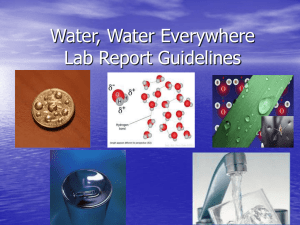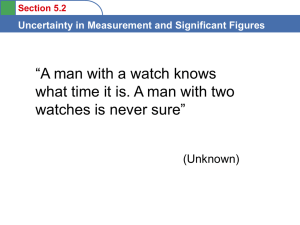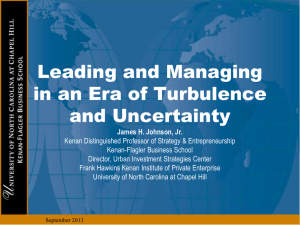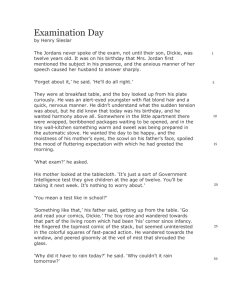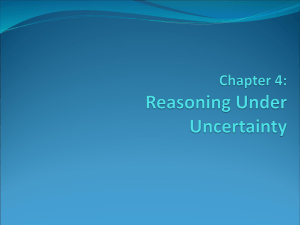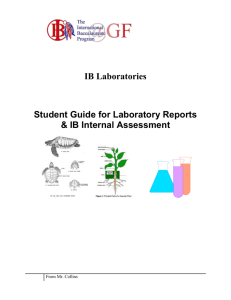“Planning for an uncertain future” Overcoming the challenges we
advertisement
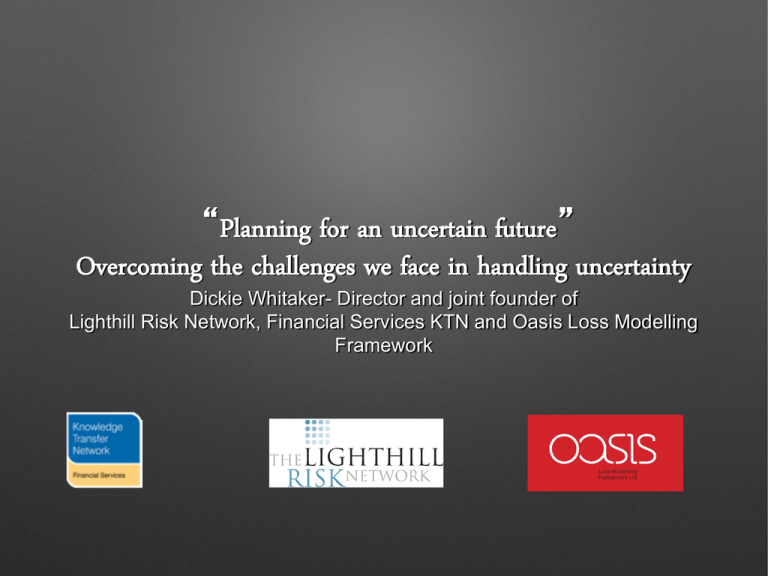
“Planning for an uncertain future” Overcoming the challenges we face in handling uncertainty Dickie Whitaker- Director and joint founder of Lighthill Risk Network, Financial Services KTN and Oasis Loss Modelling Framework “It is hard to overstate the damage done in the recent past by people who thought they knew more about the world than they really did.” John Kay in “Obliquity” 2010 Examples of where we have gone wrong • Financial crash, Efficient market hypothesis, VAR ++ If you marked your position to market every day for a million years, there would still be a less than one in a million chance of experiencing a 25standard deviation event.* • Sustainable cod management in Grand Banks Newfoundland -1968 810,000 tons of Cod caught by 1992 fishing collapsed • Japan assessment of seismicity and Tsunami wall height Cognitive Bias Mario Weick, School of Psychology, University of Kent Anchoring Anchoring describes the process of using a starting point for evaluating or estimating unknown values Gambler’s fallacy effect It describes the tendency of decision makers to underestimate the probability of a repetition of an event that has just happened (Cohen, Etner, & Jeleva, 2008). Mean-reversion bias Whereby decision makers assume that over time, a trend has to return to the mean. For example, after an ‘unusually’ high rate of a natural disaster striking, decision makers may succumb to the false believe that the rate of occurrence will return to ‘normal’. Complex problems Hypothesis weakness ‘good participants differed from the bad ones … in how often they tested their hypotheses. The bad participants failed to do this. For them, to propose a hypothesis was to understand reality; testing that hypothesis was unnecessary. Instead of generating hypotheses, they generated “truths” ’ The Logic of Failure -Dorner Losers: Acted without prior analysis Didn’t test against evidence Assumed absence of negative meant correct decisions made Blind to emerging circumstances Focused on the local not the global Avoided uncertainty Practical challenges 1. Its very challenging, we go from a simple to a complex (all possible theories and outcomes) question 2. We often do not have the resources, Time, Money Compute power or good enough statistical skills 3. Multi Disciplinary nature of the problem 4. Communication especially visual How does insurance deal with uncertainty? • Regulation didn't help that much • We cant compute (or get given) all of the uncertainty • We struggle to visualise and explain uncertainty • We struggle to combine models and results • But the market and Oasis is driving change Oasis Loss Modelling Framework Not for profit owned and funded by 23 global Insurers Reinsurers and Brokers Identification of uncertainty Model Uncertainty covers the uncertainties that exist within the scope of the model. Model inadequacy represents the unsuitability of the underlying physical hazard and vulnerability models, as well as the effect of ignoring secondary perils such as demand surge Model risk is the risk that the particular model is wrong or provides an incomplete and misleading picture. Parameter risk is the risk that the model’s parameters (often expressing assumptions or calibration factors) are wrong, and calculation error the risk that the model has been insufficiently discretised or sampled. Mean Underwriting decisions made nowadays on the basis of an “EP curve” from which three statistics are typically used: Mean Standard Deviation 1 in 200 year VaR Idealised use of models Seek transparency and ease of interrogation of any model, with clear expression of the provenance of assumptions. Communicate the estimates with humility, communicate the uncertainty with confidence. Fully acknowledge the role of judgement.” D. J. Spiegelhalter and H. Riesch in “Don’t know, can’t know: embracing deeper uncertainties when analysing risks” Phil. Trans. R. Soc. A (2011) 369, 4730–4750 What lessons for other sectors and other areas • Academia needs to have application of best practices in statistics for climate science? • We need to have more multi disciplinary approaches for science • Peer review process reinforces status quo rather than stimulating innovation and multi disciplinary approaches • Can be too much focus on “Impact” and not enough on utility • Communication and visualisation better approaches • Understanding of Bias in judgement • Computation is and will play big part as data can be Big • Use statistics in peer review Thank You & to Dr Peter Taylor & * Prof. Lenny Smith Dickie Whitaker, Director Financial Services Knowledge Transfer Network Tel: +44(0)7920 502302 email: dickie.whitaker@fs-net.org Web: http://ktn.innovateuk.org/web/financialservicesktn Dickie Whitaker- Project Director Oasis Loss Modelling Framework http://oasislmf.org/ Tel: +44(0)7920 502 302 dickie.whitaker@oasislmf.org Models and uncertainty Lenny Smith LSE; http://www.lse.ac.uk/CATS/Publications/CATS%20Papers%20-%20Chronological.aspx “Somewhere along the way, appreciation for the inherent uncertainty in risk has been diminished or even lost. Instead of models helping users to become more deeply risk-aware, the opposite ca occur. Indeed, some now feel more vulnerable to a change in model versions than to the ve catastrophes that these models were intended to mitigate.” Hemant Shah, CEO




